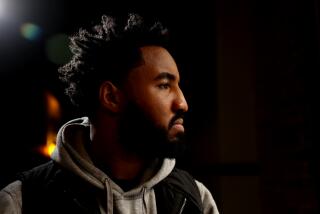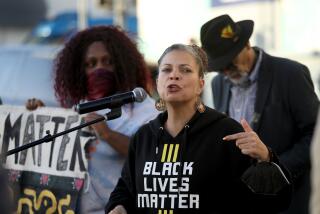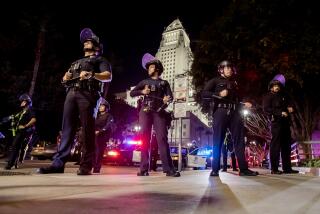L.A. protests over Ferguson decision continue for second night

As protesters poured through the streets of Los Angeles for a second night Tuesday, they chanted about change and racial injustice while rallying against a Missouri grand jury’s decision not to indict a police officer in the August death of an unarmed black man.
A diverse crowd made its way through the streets on foot and on bicycles, some pushing strollers, others leading dogs. The protest, some demonstrators explained, was about combating a sense of defeat after the grand jury’s decision.
Nicole Littleton, 48, said she attends rallies protesting police shootings or beatings whenever she can and expressed frustration over what she described as the lack of accountability for officers who engage in violence. The death of 18-year-old Michael Brown and the grand jury’s decision not to indict the white police officer who shot him, she said, was just another example.
“We’re tired of it,” she said, whistling at a group of police officers on motorcycles nearby to get their attention. “It’s wrong.”
Although the group of more than 300 protesters remained largely peaceful Tuesday, moments of tension flared.
One officer was injured when a protester threw a frozen water bottle that struck his head, an LAPD spokeswoman said. A number of protesters managed to climb onto the 101 Freeway and halted traffic. At least one police cruiser was covered with graffiti.
Police displayed restraint. By 9 p.m. Tuesday, no additional arrests had been made.
In front of LAPD headquarters, as more than 200 people demonstrated, a woman walked up to a police officer and jabbed him in the chest with her finger. “You work for me!” she shouted.
The racially diverse group, including young and old, chanted “Whoops upside the head, cop killers upside the head,” and protesters held signs that read, “Stop Killer Cops” and “Justice for Ezell Ford,” a reference to a mentally ill black man who was killed by LAPD officers days after Brown was killed.
As the protesters marched, clergy and community members gathered at Holman United Methodist Church in South L.A. to discuss how to shape the protests into something larger and more lasting.
“We can display righteous anger,” said Kelvin Sauls, who pastors the church. “This moment and these moments we’ve had must become a movement.”
Protesters first gathered in South L.A. and marched for more than six miles before stopping at the downtown headquarters of the Los Angeles Police Department, where earlier in the day Chief Charlie Beck had described the violence that had erupted Monday night in Ferguson, Mo., as “a wound of a nation that will not heal immediately.”
The chief said he was “very afraid” for both civilians and officers in Missouri, saying the images reminded him of L.A.’s own police-related riots more than two decades ago.
“When you see folks looting and fires and police cars being vandalized and the extreme degree of tension that we all saw, it does remind me of 1992,” he said, tears welling in his eyes. “But it also reminds me of how far we’ve come.”
Many protesters across the country have called for the U.S. attorney’s office to file federal civil rights charges against Wilson in Brown’s death.
For some protesters, like Dylan Farr, whether to march hardly felt like a choice.
“Even though this might not do anything,” he said, “being silent is much worse.”
Times staff writers Kate Mather, Richard Winton, Marisa Gerber, Tre’vell Anderson, Frank Shyong, Taylor Goldenstein and Samantha Masunaga contributed to this report.
More to Read
Start your day right
Sign up for Essential California for news, features and recommendations from the L.A. Times and beyond in your inbox six days a week.
You may occasionally receive promotional content from the Los Angeles Times.






